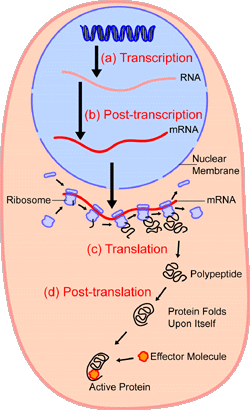
Within the nucleus of the cell (light blue), genes (DNA, dark blue) are transcribed into RNA. This RNA is then subject to post-transcriptional modification and control, resulting in a mature mRNA (red) that is then transported out of the nucleus and into the cytoplasm (peach), where it undergoes translation into a protein. mRNA is translated by ribosomes (purple) that match the three-base codons of the mRNA to the three-base anti-codons of the appropriate tRNA. Newly synthesized proteins (black) are often further modified, such as by binding to an effector molecule (orange), to become fully active.
Protein biosynthesis (Synthesis) is the process in which cells build proteins. The term is sometimes used to refer only to protein translation but more often it refers to a multi-step process, beginning with amino acid synthesis and transcription which are then used for translation. Protein biosynthesis, although very similar, differs between prokaryotes and eukaryotes.
Contents |
Amino acid synthesis
Amino acids are the monomers which are polymerized to produce proteins. Amino acid synthesis is the set of biochemical processes (metabolic pathways) which build the amino acids from carbon sources like glucose. Not all amino acids may be synthesised by every organism, for example adult humans have to obtain 8 of the 20 amino acids from their diet.
The amino acids are then loaded onto tRNA molecules for use in the process of translation.
Transcription
Transcription is the process by which an mRNA template, carrying the sequence of the protein, is produced for the translation step from the genome. Transcription makes the template from one strand of the DNA double helix, called the template strand. Transcription takes place in 3 stages.
- Transcription starts with the process of initiation. RNA polymerase, the enzyme which produced RNA from a DNA template, binds to a specific region on DNA that designates the starting point of transcription. This binding region is called the promoter. As the RNA polymerase binds on to the promoter, the DNA strands are beginning to unwind.
- The second process is elongation. RNA polymerase travels along the template (noncoding) strand, synthesizing a ribonucleotide polymer. RNA polymerase does not use the coding strand as a template because a copy of any strand produces a base sequence complementary to the strand which is being copied. Therefore DNA from the noncoding strand is used as a template to copy the coding strand.
- The third stage is termination. As the polymerase reaches the termination stage, modifications are required for the newly transcribed mRNA to be able to travel to the other parts of the cell, including cytoplasm and endoplasmic reticulum for translation. A 5' cap is added to the mRNA to protect it from degradation. In eukaryotes a poly-A tail is added on the 3’ end for protection and as a template for further process. Also in eukaryotes (higher organisms) the vital process of splicing occurs at this stage.
Translation
During translation, mRNA previously transcribed from DNA is decoded by specialized cellular structures called ribosomes to make proteins. Protein biosynthesis is divided into initiation, elongation and termination phases.
The ribosome has sites, which allow another specialized RNA molecule, known as tRNA, to bind to the mRNA. Binding of the correct tRNA to the mRNA on the ribosome is accomplished by an "anticodon" that is part of the tRNA. Thus, the correct tRNA, chemically linked to a specific amino acid, is directed to the ribosome to be added to a growing (nascent) polypeptide. The chemical process of connecting two amino acids is shown in the picture below.
As the ribosome travels down the mRNA one codon at a time, another tRNA is attached to the mRNA at one of the ribosome sites. The first tRNA is released, but the amino acid that is attached to the first tRNA is now moved to the second tRNA, and binds to its amino acid. This translocation continues on, and a long chain of amino acid (protein), is formed.
When the entire unit reaches the stop codon on the mRNA, it falls apart and a newly formed protein is released. This is termination. It is important to know that during this process, many enzymes are used to either assist or facilitate the whole procedure.
Events following biosynthesis (Protein Synthesis)
The events following biosynthesis include post-translational modification and protein folding. During and after synthesis, polypeptide chains often fold to assume, so called, native secondary and tertiary structures. This is known as protein folding.
Many proteins undergo post-translational modification. This may include the formation of disulfide bridges or attachment of any of a number of biochemical functional groups, such as acetate, phosphate, various lipids and carbohydrates. Enzymes may also remove one or more amino acids from the leading (amino) end of the polypeptide chain, leaving a protein consisting of two polypeptide chains connected by disulfide bonds.
See also
External links
- Science aid:Protein synthesis For high school
- Protein Synthesis (Flash Animation)
- Protein Synthesis
- [Transcription]
- Protein Synthesis Animation Wesleyan University Learning Objects animation of protein synthesis.




 216.73.216.81
216.73.216.81 User Stats:
User Stats:
 Today: 0
Today: 0 Yesterday: 0
Yesterday: 0 This Month: 0
This Month: 0 This Year: 0
This Year: 0 Total Users: 117
Total Users: 117 New Members:
New Members:
 216.73.xxx.xx
216.73.xxx.xx
 Server Time:
Server Time:
